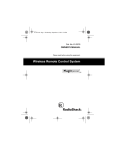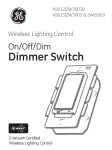Download Z-Wave RC-100 Specifications
Transcript
GE Security IS-ZW-RC-1 Remote Control Installation Sheet Description Figure 1: Remote control Z-Wave technology is designed to automate lighting/home control and provides easy remote operation of all your Z-Wave enabled devices. The GE Z-Wave family includes a variety of devices to control lighting in your home. LCD screen The remote control (model IS-ZW-RC-1) allows you to control up to 18 individual Z-Wave devices with one easy-to-use, compact unit. You can also set up and control up to 18 groups of lights as well as 18 scenes for task or mood lighting. Groups can include up to 232 Z-Wave devices and each scene can include up to 32 Z-Wave devices. Lights can be included in multiple groups. Scenes can include lights from different groups. Your Z-Wave home control network can include up to 232 Z-Wave enabled devices. Mode buttons Menu selection buttons LIGHT OK 1 • Event programming • Control of a Z-Wave enabled thermostat for your HVAC system CANCEL 2 ALL 3 ON ON ON OFF OFF OFF 4 5 6 ON ON ON OFF OFF OFF 7 8 9 ON ON ON OFF OFF OFF Number buttons An easy to use LCD menu system SCENE SHIFT SETUP Additional features include: • GROUP This remote is based on the Z-Wave Controller Library and the Remote Controller Generic Device Class. It controls devices that support the following Z-Wave Command Classes: • Basic Command Class • Binary Switch Command Class • Configuration Command Class The unit provides the following: • Controller Replication Command Class LCD screen. Easy to use menu structure. • Manufacturer Specific Command Class Mode buttons: • Multilevel Switch Version 1 Command Class • Thermostat Command Class • Version Command Class LIGHT button. Use to program and/or control individual lights. GROUP button. Use to program and/or turn multiple lights on or off with one button. Note: When using the Basic Command Class to control devices, the remote will either transmit a value of 0 or 255, depending on the button pressed. SCENE button. Use to program and/or control multiple lights at preset brightness levels. The same light may be included in multiple scenes. Node is the technical term used to describe a Z-Wave device in a home control network. Please note that the terms “Node”, “Device”, and “Light” all refer to an individual Z-wave enabled device and are interchangeable within the context of these instructions. Thermostat icon button. Use to check and adjust system and temperature settings on a Z-Wave enabled thermostat. Menu selection buttons. Use arrow buttons to scroll between menu items. Press OK to select the displayed menu item. © 2009 GE Security, Inc. 1 of 8 P/N 1069507 • REV A • ISS 18NOV09 SETUP/SHIFT button. Press and hold to enter setup mode. You can then add lights to, or delete lights from your control network. You can create or modify groups and scenes. Press and release to shift number buttons from 1 through 9 to 10 through 18. CANCEL button. Press and release to cancel the current programming operation. ALL button. Use to turn on or off all Z-Wave lighting at the same time. Press ALL and then any number button. Number buttons. Use to control up to 18 individual lights, 18 groups, and 18 scenes. Press and release to turn on or off. Press and hold to adjust brightness. Press the button for numbers 1 to 9; press SHIFT, then the button for numbers 10 to 18. If this remote is used as the primary controller, you must use it to create your control network. You can use multiple remote controls with your Z-Wave lighting control network, however; only one remote will act as the primary controller. The primary controller must be used to add or delete devices (lights/nodes) from your network. All other controllers are considered secondary and can be used to create groups and/or scenes and control your lighting, however, secondary controllers cannot add or delete devices from your network. Note: This product can be operated in one Z-Wave network with Z-Wave certified devices. WARNING: Due to risk of fire, electrical shock and burns, exercise extreme caution when using Z-Wave devices to control appliances. Operation of the Z-Wave device may be in a different room than the controlled appliance, also an unintentional activation may occur if the wrong button on the remote is pressed. Z-Wave devices may automatically be powered on due to timed event programming. Depending upon the appliance, these unattended or unintentional operations could possibly result in a hazardous condition. For these reasons, we recommend the following installation guidelines. Installation guidelines • Assign Z-Wave controlled appliances to device numbers 10 to 18 on the remote. The likelihood of unintentionally turning on the appliance will be reduced significantly because the Shift button will need to be pressed before pressing device numbers 10 to 18. • Z-Wave devices controlling appliances should be removed from the “All” control setting. See “All-on and all-off control” on page 6. • Do not include Z-Wave devices in groups or scenes if they control appliances. • Do not use Z-Wave devices to control electric heaters or any other appliances that may present a hazardous condition due to unattended, unintentional, or automatic power on control. • Double check programming for accuracy. For best results, please read and perform all the remaining instructions before using the remote. Installation Batteries Three AAA alkaline batteries (not included) are required: • Use only fresh batteries of the required size and recommended type. • Do not mix old and new batteries or different types of batteries. • If you do not plan to use the remote for an extended period, remove the batteries. They can leak chemicals that can destroy electronic parts. • Dispose of old batteries promptly and properly. Do not burn or bury them. • Replace fully discharged batteries immediately. To install batteries: Caution: Not for use with medical or life support equipment. ZWave enabled devices should never be used to supply power to, or control the on/off status of medical and/or life support equipment. Wireless range This device complies with the Z-Wave standard of open-air, line of sight transmission distances of 100 feet. Actual performance in a home depends on the number of walls between the remote controller and the destination device, the type of construction, and the number of Z-Wave enabled devices installed in the control network. Every Z-Wave enabled device acts as a signal repeater and multiple devices result in more possible transmission routes, which help eliminate “RF dead spots”. RF range guidelines • Each wall or obstacle (such as a refrigerator or big screen TV) between the remote or a Z-Wave device and the destination device will reduce the maximum range by approximately 25 to 30 percent. 1. Open the battery compartment cover (located on the back of the remote). 2. Note the + and – polarity symbols inside the battery compartment. • Brick, tile, or concrete walls block more of the RF signal than walls made of wooden studs and plasterboard (drywall). 3. Insert the batteries; making sure their polarity matches the symbols in the compartment. • 4. Replace the cover. Wall mounted Z-Wave devices installed in metal junction boxes will suffer a significant loss of range (approximately 20 percent) since the metal box blocks a large part of the RF signal. • Z-Wave home control networks are designed to work properly alongside 802.11 wireless computer networks, Bluetooth and other 2.4GHz or 5.8GHz devices. Some baby 2 of 8 P/N 1069507 • REV A • ISS 18NOV09 cams, wireless video devices and older cordless phones using the 900MHz frequency range may cause interference and limit Z-Wave functionality. Many 900 MHz products have a switch to select channel “A” or “B”. You may find that one of these channels will cause less interference than the other channel. Network management Your remote control and every Z-Wave device you have added with the primary controller are linked together in a wireless network. Each device in your network has a unique address assigned to it and cannot be activated by your neighbor’s Z-Wave controller. The screen displays ADD. 3. The screen displays TO NETWORK. 4. Scroll until the screen displays TO A KEY, and then press OK. 5. Press a digit (1 to 9) for the device location you wish to add. Press SETUP (SHIFT) and the digit (1 to 9) if you are adding devices 10 through 18. 6. Press OK. The screen displays SETUP WAITING. 7. Add a node, group, or scene can also be referred to as include a node, group, or scene. Remove a node, group, or scene can also be referred to as exclude a node, group, or scene. If the screen displays FAILURE during the setup or programming process, you have pressed an invalid key or the desired action has not been successfully completed. Make sure the remote is within two feet of the device and try again. Adding a device In order to control lights, they must be Z-Wave enabled and you must first add them to your home network. There are two ways to do this. • • Add lights to your remote so that they can be controlled individually using the number keys (maximum of 18). Adding a device to your remote also adds it to your network. If the device number you are trying to add is already associated with another device, the previous information is lost. Add devices to your home network without assigning them to a specific number key. These devices can only be controlled through the Group, Scene, or All commands. Press OK. Press the button on the device so that it communicates with the remote. The screen displays SUCCESS to indicate that the Node/Light has been successfully added to the number key and your network. Controlling individual lights You can control a light to turn it on or off, or change its brightness level. The operation of a specific device varies by product. Refer to the manual for that device to learn its specific operation. 1. Press and release the LIGHT key to put the remote into individual light control mode. The remote will stay in this mode until the Group, Scene, or All mode is activated. 2. Select the lights you want to control. Press and release SHIFT to control lights 10 to 18. To turn a light on or off: • • To turn a light on, press and release the ON key for less than one second. The screen displays the selected light and ON. To turn a light off, press and release the OFF key for less than one second. The screen displays the selected light and OFF. To add a device without assigning it to a specific number key: To set a light’s brightness level: 1. Press and hold SETUP until the screen shows LIGHT SETUP. • 2. Press OK. The screen displays ADD. 3. Press OK. • The screen displays TO NETWORK. 4. 5. Press OK. To make a light brighter, press and hold the ON key for more than one second. The screen displays the selected light and BRIGHT. The light will continue to grow brighter until the key is released. To make a light dimmer, press and hold the OFF key for more than one seconds. The screen displays the selected light and DIM. The light will continue to grow dimmer until the key is released. The screen displays SETUP WAITING. To remove a device from your remote: Press the button on the device so that it communicates with the remote. 1. Press and hold SETUP until the screen displays LIGHT SETUP. The screen displays SUCCESS to indicate that the Node/Light has been successfully added. 2. Press OK. 3. Scroll until the screen displays REMOVE, and then press OK. You can now add the device to groups and/or scenes. To add a device and assign it to a specific number key: 1. Press and hold SETUP until the screen displays LIGHT SETUP. 2. Press OK. P/N 1069507 • REV A • ISS 18NOV09 The screen displays SEL DIGIT. 4. Press a digit (1 to 9) for the device location you wish to remove. Press SHIFT and the digit (1 to 9) if you are removing devices 10 through 18. 5. Press OK 3 of 8 The screen displays SUCCESS. 2. This only removes individual number key control. The device is still part of your home control network and can be controlled through the GROUP, SCENE, and ALL controls. To delete a device from your network: 1. Press and hold SETUP until the screen displays LIGHT SETUP. 2. Press OK, and then press the right arrow key two times. The screen displays DELETE. 3. Press OK. 4. Press the button on the device so that it communicates with the remote. The screen displays the selected group. 3. Groups Multiple Z-Wave devices can be turned on or off with a single command when they are placed in a group. One example would be grouping your porch light, exterior garage lights, and patio lights together so that they can all be turned on if you hear a strange sound in the middle of the night. You can set up a maximum of 18 groups. A group can contain up to 232 devices. To remove a device from a group: 1. Press and hold SETUP until the screen displays LIGHT SETUP. 2. Scroll until the screen displays GRP SETUP, and then press OK. 3. Press the right arrow key once. The screen displays REMOVE. 4. Press and hold SETUP until the screen displays LIGHT SETUP. 2. Scroll until the screen displays GRP SETUP, and then press OK. The screen displays ADD. 3. 4. 5. 5. Press a digit (1 to 9) for the group from which you want to remove the device. Press SHIFT and the digit (1 to 9) if you are removing a device from groups 10 through 18. 6. Press OK. The screen displays SETUP WAITING. 7. The screen displays SUCCESS. This only removes the device from a specific group. The device is still part of your home control network and the group still exists (if it included more than one device). To delete a group: Press and hold SETUP until the screen displays LIGHT SETUP. The screen displays SEL DIGIT. 2. Press the digit (1 to 9) for the group to which you wish to add the device. Press SHIFT and the digit (1 to 9) if you are adding a device to groups 10 through 18. Scroll until the screen displays GRP SETUP, and then press OK. 3. Press the right arrow key two times. Press OK. Press the button on the device so that it communicates with the remote. The screen displays DELETE. 4. To control a group: Press GROUP to put the remote into Group control mode. The screen displays GROUP. The remote will stay in this mode until the Light, Scene, or All mode is activated. 4 of 8 Press OK. The screen displays SEL DIGIT. 5. Press a digit (1 to 9) for the group you wish to delete. Press SHIFT and the digit (1 to 9) if you are deleting groups 10 through 18. 6. Press OK. The screen displays SUCCESS. 1. Press the button on the device you wish to remove. 1. Press OK. The screen displays SETUP WAITING. 6. Press OK. The screen displays SEL DIGIT. To create or add a device to a group: 1. To turn a group on, press and release the ON key for less than one second. The screen displays the selected group and ON. To turn a group off, press and release the OFF key for less than one second. The screen displays the selected group and OFF. The screen displays SUCCESS. This completely removes the device from your home control network and resets the device to its factory default settings. Press the digit key for the group you wish to control (1 to 9). Press SHIFT and the digit (1 to 9) if you are controlling groups 10 through 18. The screen displays SUCCESS. This only deletes the specific group. All of the devices are still part of your home control network. P/N 1069507 • REV A • ISS 18NOV09 Scenes The screen displays SETUP WAITING. A scene lets you establish preset brightness levels for multiple ZWave controlled lights and then control them with one command. This is ideal for mood or task lighting. Scene 1 could be the family room lights set to dim for watching TV. Scene 2 could have the same lights set to a different brightness level for other activities like reading or entertaining. 7. Press the button on the device you wish to remove. You can set up a maximum of 19 scenes, containing up to 32 devices per scene. Scenes can include lights from different groups. To delete a scene: The screen displays SUCCESS. This only removes the device from a specific scene. The device is still part of your home control network and the scene still exists (if there were more than one device in it). 1. Press and hold SETUP until the screen displays LIGHT SETUP. To add a device to a scene: 1. Press and hold SETUP until the screen displays LIGHT SETUP. 2. Scroll until the screen displays SCN SETUP, and then press OK. 2. Scroll until the screen displays SCN SETUP, and then press OK. 3. Press the right arrow key two times. The screen displays ADD. 3. The screen displays DELETE. 4. Press OK. The screen displays SEL DIGIT. 4. Press a digit (1 to 9) for the scene to which you wish to add the device. Press SHIFT and the digit (1 to 9) if you are adding devices to scenes 10 through 18. 5. Press OK. The screen displays SEL DIGIT. 5. Press the button on the device that you are adding, and adjust the brightness level on the device within 30 seconds (refer to the manual for the device). The screen displays SUCCESS. To control a scene: 1. Press SCENE to put the remote in Scene mode. The remote will stay in this mode until the Light, Group, or All mode is activated. 2. Press the digit key for the scene you wish to control (1 to 9). Press SHIFT and the digit (1 to 9) if you are controlling scenes 10 through 18. The screen displays SCENE and the digit selected. To remove a device from a scene: 1. Press and hold SETUP until the screen displays LIGHT SETUP. 2. Scroll until the screen displays SCN SETUP, and then press OK. 3. Scroll until the screen displays REMOVE. 4. Press OK. 6. 6. Press OK. The screen displays SUCCESS. This only deletes the specific scene. All of the devices are still part of your home control network. Labels Individual lights, groups, or scenes can all be labeled to help identify their function or location in your home. The process is the same for all three. To create labels: 1. Press and hold SETUP until the screen displays LIGHT SETUP. Scroll to GROUP or SCENE if changing those labels. 2. Press OK The screen displays ADD. 3. Scroll until the screen displays LABEL, and then press OK. The screen displays SEL DIGIT. 4. Press a digit (1 to 9) for the light, group, or scene you wish to rename. Press SHIFT and the digit (1 to 9) if you are renaming 10 through 18. The screen displays the selected light, group, or scene. 5. Use the 1 On/Off key to scroll through the alphabet/numbers until you reach the appropriate letter or number. Press a digit (1 to 9) for the scene from which you want to remove the device. Press SHIFT and the digit (1 to 9) if you are removing a device from scenes 10 through 18. 6. Use the right arrow key to move to the next letter and repeat step 5. 7. Continue this process until your new label is complete. Press OK. 8. Press OK. The screen displays SEL DIGIT. 5. Press a digit (1 to 9) for the scene you wish to delete. Press SHIFT and the digit (1 to 9) if you are deleting scenes 10 through 18. The screen displays the selected scene. The screen displays SETUP WAITING. 6. Press OK. P/N 1069507 • REV A • ISS 18NOV09 5 of 8 The screen displays SUCCESS. 3. Press OK. The screen displays TIME 12 hr. All-on and all-off control Press ON or OFF with the 1 key to adjust the hour. The factory default setting for Z-Wave lighting control devices is to be included in all-on and all-off control. Press ON or OFF with the 2 key to adjust the minutes. To turn all devices on or off: 1. 4. Press ALL once. The screen displays ALL. 2. Press ON or OFF with the 3 key to toggle between AM and PM. Press either ON or OFF (you can press any ON or OFF button). Once you have set up the correct time, press OK. The screen displays SUCCESS. To set the date: 1. Press and hold SETUP until the screen displays LIGHT SETUP. 2. To add devices to All control mode: Scroll until the screen displays DATE/TIME, and then press OK. 1. Press and hold SETUP until the screen displays LIGHT SETUP. The screen displays TIME. 2. Scroll until the screen displays ALL SETUP, and then press OK The screen displays ALL ON or ALL OFF, depending on the key you pressed. 3. The screen displays the default date. Press ON or OFF with the 1 key to adjust the month. The screen displays EX ON/OFF. 3. 4. Press ON or OFF with the 2 key to adjust the day. Scroll until the screen displays INC ON/OFF, and then press OK. The screen displays SETUP WAITING. Press the button on the device that you wish to add to All control mode. The screen displays SUCCESS. Press ON or OFF with the 3 key to toggle between years. 4. Press and hold SETUP until the screen displays LIGHT SETUP. 2. Scroll until the screen displays ALL SETUP, and then press OK. To set the current day: 1. Press and hold SETUP until the screen displays LIGHT SETUP. 2. Scroll until the screen displays DATE/TIME, and then press OK. The screen displays TIME. 3. The screen displays EX ON/OFF. 3. 4. Once you have set up the correct date, press OK. The screen displays SUCCESS. To delete devices from All control mode: 1. Scroll until the screen displays DATE, and then press OK. Press the right arrow twice. The screen displays DAY. Press OK. 4. The screen displays SETUP WAITING. Note: The DTS and Time Zone settings are reserved for future use. Press the button on the device that you wish to remove from All control mode. The screen displays SUCCESS. Time and date setup You will need to reprogram the date and time when the batteries are replaced. Scroll until the current day is displayed, and then press OK.. Events An event is something you want to happen at a specific time and day. This could be everyday, a specific day of the week, Monday through Friday, Saturday and Sunday only, or a one-time occurrence. Events can be set up to control an individual device, a group, or a scene. To set the time: The remote allows you to program up to 15 automated events. You must set the time and date before programming an event. 1. Press and hold SETUP until the screen displays LIGHT SETUP. To add an event: 2. Scroll until the screen displays DATE/TIME, and then press OK. The screen displays TIME. 6 of 8 1. Press and hold SETUP until the screen displays LIGHT SETUP. 2. Scroll until the screen displays EVENTS, and then press OK. P/N 1069507 • REV A • ISS 18NOV09 3. The screen displays ADD. 4. Press the digit for the event you want to delete. Press OK. 5. Press OK. The screen displays SUCCESS. The screen displays EVERY DAY. Use either arrow key to change this option to MON-FRI, SATSUN, ONE TIME, or a specific day of the week. 4. Once you have chosen the event profile, press OK. The screen displays SEL DIGIT. To enable all programmed events: 1. Press and hold SETUP until the screen displays LIGHT SETUP. 2. Scroll until the screen displays EVENTS, and then press OK. 3. Scroll until the screen displays ALL, and then press OK. 5. Press any digit and the screen displays the event number. 6. Press OK and the screen displays ENABLED. 7. Press OK and the screen displays EVENT TYPE. 8. Scroll between the Light, Scene, or Group options (pressing digits 1 to 9 will adjust the Light number accordingly). 9. After you select the event type, press OK. To disable all programmed events: The screen displays ON TIME. 1. Press and hold SETUP until the screen displays LIGHT SETUP. 2. Scroll until the screen displays EVENTS, and then press OK. 3. Scroll until the screen displays ALL, and then press OK. The screen displays ALL ON. 4. The screen displays SUCCESS. Press ON or OFF with the 1 key to adjust the hour. Press ON or OFF with the 2 key to adjust the minutes. Press ON or OFF with the 3 key to toggle between AM and PM. The screen displays ALL ON. 10. Press OK once you have programmed the ON TIME. The screen displays OFF TIME. Press ON or OFF with the 1 key to adjust the hour. 4. Press either arrow key and the screen displays ALL OFF. 5. Press OK. The screen displays SUCCESS. Press ON or OFF with the 2 key to adjust the minutes. Press ON or OFF with the 3 key to toggle between AM and PM. 11. Once you have programmed the off time, press OK. The screen displays SUCCESS. Press OK. Thermostats The remote allows you to program and control a Z-Wave enabled thermostat. Random events To add a thermostat to the remote control: The event feature allows you to program automated events, such as turning your lights on or off at a predetermined time and day. By choosing the Random option, the event will start at +/- 15 minutes of the scheduled time. 1. Press and hold SETUP until the screen displays LIGHT SETUP. 2. Scroll until the screen displays THERMOSTAT, and then press OK. To activate this function, after step 6 above, use either arrow key to scroll until the screen displays RANDOM. Press OK and the screen displays EVENT TYPE. Continue the programming as shown in step 8 above. The screen displays ADD. 3. Press OK. The screen displays SETUP WAITING. Disabling an event Once an event has been programmed, you can disable it by following steps 1 to 6 above and then scrolling to DISABLED and pressing OK. To delete an event: 1. Press and hold SETUP until the screen displays LIGHT SETUP. 2. Scroll until the screen displays EVENT, and then press OK. The screen displays ADD. 3. Scroll until the screen displays DELETE, and then press OK The screen displays SEL DIGIT. P/N 1069507 • REV A • ISS 18NOV09 4. Press the button on the thermostat’s Z-Wave interface. The screen displays SUCCESS. Controlling a thermostat The features and functions that can be controlled vary by thermostat and you will need to refer to the documentation provided with the thermostat to determine the capabilities of your thermostat. If supported by the thermostat, the remote allows you to check room temperature, adjust HVAC system modes (Heat, Cool, Fan, and AUTO) and adjust temperature settings (setpoint). Please note that your HVAC system may have to be set to Heat or Cool mode in order to remotely check and/or adjust the room temperature. 7 of 8 To delete a thermostat from the remote control: Interoperability with Z-Wave devices 1. Press and hold SETUP until the screen displays LIGHT SETUP. 2. Scroll until the screen displays THERMOSTAT, and then press OK. A Z-Wave network can integrate devices of various classes. Although every Z-wave certified product is designed to work with all other Z-Wave certified products, the remote control includes the appropriate device classifications in order to control nonlighting Z-Wave devices. The screen displays ADD. 3. Scroll until the screen displays DELETE, and then press OK. Specifications The screen displays SETUP WAITING. Operating voltage 4.5 V Battery type AAA heavy duty or Alkaline 2.9 V min., 4.5 V nom., 4.95 V max. Low battery indication 2.4 V min., 2.8 V max. Advanced configuration Standby current 120 uA max. Some Z-Wave devices provide advanced capabilities available only with a remote control. Refer to the documentation provided with the Z-Wave device for available options and specific parameter and byte values. Operating current 19 mA min., 27 mA nom., 50 mA max. Range Up to 100 feet line of sight between the wireless controller and the closest Z-Wave receiver module 4. Press the button on the thermostat’s Z-Wave interface. The screen displays SUCCESS. Operating temperature 32 to 122ºF (0 to 50ºC) To change advanced configuration settings: Storage temperature -20 to 140ºF (-20 to 60ºC) 1. Press and hold SETUP until the screen displays LIGHT SETUP. For indoor use only 2. Scroll until the screen displays ADV CONFIG, and then press OK. The screen displays PARAM 0. 3. Scroll until the screen displays the proper parameter number (1 to 255), and then press OK. The screen displays NUM BYTES. 4. Scroll until the screen displays the proper number of bytes (1, 2, or 4), and then press OK. 5. Press the button on the device. The screen displays SUCCESS. Recovering network information The recovery function is used to rebuild the routing table within the remote control. This table identifies which Z-Wave devices can communicate with other Z-Wave devices on the network and helps ensure that commands are transmitted and repeated through the most efficient route to your destination device. To have your remote control recover network information: 1. Press and hold SETUP until the screen displays LIGHT SETUP. 2. Scroll until the screen displays NETWORK, and then press OK. FCC This device complies with Part 15 of the FCC Rules. Operation is subject to the following two conditions: (1) this device may not cause interference, and (2) this device must accept any interference, including interference that may cause undesired operation. If this equipment does cause harmful interference to radio or television reception, which can be determined by turning the equipment off and on, the user should: • • Reorient or relocate the TV or radio antenna. Increase the separation between the device and receiver. Any changes or modification to the equipment without express consent will void the user’s right to operate this equipment. FCC ID: MG345601 IC: 6924A-45601 Model: 45601 Contact information For contact information see our Web site: www.gesecurity.com. The screen displays RESET. 3. Scroll until the screen displays RECOVERY, and then press OK. When the screen displays COMPLETE, you have successfully recovered network information. 8 of 8 P/N 1069507 • REV A • ISS 18NOV09


















